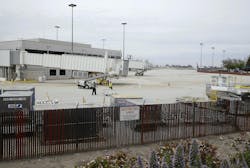May 01--Three weeks before a teenager climbed a fence at San Jose Mineta International Airport and stowed away in the wheel well of an airliner, the Transportation Security Administration inspected and approved the airport's fence line security.
The disclosure by TSA administrator John S. Pistole during testimony before the U.S. Senate Commerce Committee on Wednesday is likely to add increasing pressure for improvements to airport perimeter security around the nation.
"What if it was someone else with an explosive that got on that plane?" asked Sen. Barbara Boxer, D-Calif., who grilled Pistole about the San Jose incident. "Hey, this is bad news." She added later, "You cleared them and that's troubling to me."
Pistole said the TSA has been working "almost nonstop" to find out what happened.
The youth entered the airport under the cover of darkness. While airport officials have said they do not have video of the teen climbing the fence, they do have film of an unidentified intruder on the tarmac, but no one monitoring the closed-circuit video system saw it. Pistole said the airport could be fined "for allowing this to happen because it is an egregious violation of the airport's perimeter."
The Santa Clara youth, who apparently was trying to get back to his mother in Africa, somehow survived a 51/2 hour flight to Maui in the wheel well of a Hawaiian Airlines jet, landing there on April 21.
In prepared talking points, Pistole said that from Jan. 2 to March 28, TSA conducted a comprehensive inspection of the airport and found it met security requirements for perimeter systems, including the fence line and other measures.
Inspectors reviewed physical barriers and electronic access control systems; the airport's badging system; training; law enforcement support; contingency plans; and adherence to specific directives from the TSA, according to Pistole's talking points.
The airport also has a project to enhance its standards for the fence line, he noted.
The TSA regulates and inspects the security arrangements of airports outside the terminal, but airports pay for and operate the systems. Television cameras to monitor fences are not required, according to a TSA spokesman.
TSA's requirements call for a six-foot fence around airports. San Jose has an extra foot of barbed wire atop an estimated six miles of fence enclosing the airport, according to airport spokeswoman Rosemary Barnes.
"We've always met TSA standards," Barnes said. "We've been sharing that message all along. The fence meets and in many cases exceeds standards. We've always done what we've been asked to do."
Brian Jenkins, a senior adviser to the president of the RAND Corp., said in an interview Wednesday that improving fence security has a low priority because no intrusion has ever resulted in a fatality. Beefing up fences with cameras and other gear is expensive, he added, and airports have to pay for it. Jenkins also directs the National Transportation Security Center at the Mineta Transportation Institute at San Jose State.
Pistole said that each airport is different.
"With 450 airports, there is no one-size-fits-all for each airport, so we inspect each one to assess for that location ... the perimeter fencing, along with a number of other things."
He said San Jose's fencing "was in fine shape, but as at least one prior Secretary of Homeland Security said, 'show me a 15-foot fence and I'll show you a 16-foot ladder. ... What we do is try to buy down risk in a measured fashion that allows us to make sure that we are doing everything possible."
Pistole said there are "a number of opportunities" for improving security along the fence line. "There could be armed officers, or with canines out patrolling. There could be better CCTV (closed circuit television) coverage. There could be a second fence in some situations," he said.
But he also observed that if Congress doesn't allocate money for enhanced security on fences, "those are unfunded mandates for the airports." A group of several congressmen is asking the Government Accountability Office to update a 2009 report on airport perimeter security. Since that report was issued, five other airports have reported perimeter violations.
Contact Pete Carey at 408-920-5419. Follow him on Twitter.com/petecarey.
Copyright 2014 - San Jose Mercury News

